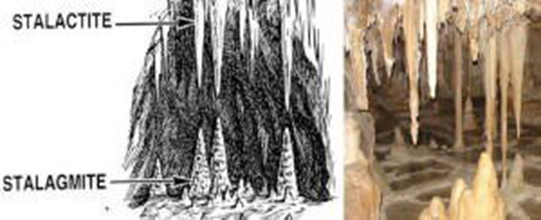TAG: GS-1: GEOGRAPHY & GS-3: ECONOMY
The context: New sedimentary rock made from slag has recently (in 2024) been a carbon-trapping champ.
Explanation:
Sedimentary Rocks or Detrital Rocks
- Sedimentary rocks are formed by lithification ― consolidation and compaction of sediments.
- Hence, they are layered or stratified of varying thickness. Example: sandstone, shale etc.
- Sediments are a result of denudation (weathering and erosion) of all types of rocks.
- These types of rocks cover 75 per cent of the earth’s crust but volumetrically occupy only 5 per cent (because they are available only in the upper part of the crust).
- Ice deposited sedimentary rocks are called till or tillite. Wind-deposited sediments are called loess.
Depending upon the mode of formation, sedimentary rocks are classified into:
1. mechanically formed — sandstone, conglomerate, limestone, shale, loess.
2. organically formed — geyserite, chalk, limestone, coal.
3. chemically formed — limestone, halite, potash.
Mechanically Formed Sedimentary Rocks
- They are formed by mechanical agents like running water, wind, ocean currents, ice, etc.
- Arenaceous sedimentary rocks have more sand and bigger sized particles and are hard and porous. They form the best reservoirs for liquids like groundwater and petroleum. E.g. sandstone.
- Argillaceous rocks have more clay and are fine-grained, softer, mostly impermeable (mostly non-porous or have very tiny pores). E.g. claystone and shales are predominantly argillaceous.
Chemically Formed Sedimentary Rocks
- Water containing minerals evaporate at the mouth of springs or salt lakes and give rise to Stalactites and stalagmites (deposits of lime left over by the lime-mixed water as it evaporates in the underground caves).

Organically Formed Sedimentary Rocks:
- The remains of plants and animals are buried under sediments, and due to heat and pressure from overlying layers, their composition changes. Coal and limestone are well-known examples.
- Depending on the predominance of calcium content or the carbon content, sedimentary rocks may be calcareous (limestone, chalk, dolomite) or carbonaceous (coal).
The Characteristics of Sedimentary Rocks:
- They are stratified ― consist of many layers or strata.
- They hold the most informative geological records due to the marks left behind by various geophysical (weather patterns, wind and water flow) and biological activities (fossils).
- They are fossiliferous ― have fossils of plants and animals.
- These rocks are generally porous and allow water to percolate through them.
The spread of Sedimentary Rocks in India
- Alluvial deposits in the Indo-Gangetic plain and coastal plains is of sedimentary accumulation. These deposits contain loam and clay.
- Different varieties of sandstone are spread over Madhya Pradesh, eastern Rajasthan, parts of Himalayas, Andhra Pradesh, Bihar and Orissa.
- The great Vindhyan highland in central India consists of sandstones, shales, limestones.
- Coal deposits occur in river basins of the Damodar, Mahanadi, the Godavari in the Gondwana sedimentary deposits.
Economic Significance of Sedimentary Rocks
- Sedimentary rocks are not as rich in minerals of economic value as the igneous rocks.
- But important minerals such as hematite iron ore, phosphates, building stones, coals, petroleum and material used in the cement industry are found.
- The decay of tiny marine organisms yields petroleum. Petroleum occurs in suitable structures only.
- Important minerals like bauxite, manganese, tin, are derived from other rocks but are found in gravels and sands carried by water.
Source:
Spread the Word
